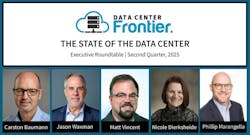Executive Roundtable: Defining Real Innovation in the Data Center of 2025
For the final installment of our Q2 2025 Executive Roundtable, Data Center Frontier asked a fundamental question: What does real innovation look like in today’s data center industry?
With AI driving massive investment and vendors racing to stake claims around sustainability, modularity, and performance, it can be difficult to distinguish genuine breakthroughs from marketing spin. We challenged our panel of experienced infrastructure leaders to cut through the noise and share where they see true progress taking shape.
From overlooked advances in power architecture to strategic shifts in procurement, our experts highlight the innovations, both technical and operational, which they believe will have a lasting impact over the next 12 to 18 months.
The seasoned data center industry leaders of our Executive Roundtable for the Second Quarter of 2025 include:
- Jason Waxman, CEO, CoolIT Systems
- Phillip Marangella, Chief Marketing and Product Officer, EdgeConneX
- Nicole Dierksheide, Global Category Director for Large Power, Rehlko
- Carsten Baumann, Director, Strategic Initiatives and Solution Architect, Schneider Electric
And now, on to our final Executive Roundtable question for Q2 of 2025.
Data Center Frontier: What does meaningful innovation in the data center sector look like right now? In a marketplace crowded with bold claims and emerging technologies, how do you separate marketing noise from truly transformative innovation? And what is one underappreciated technical or strategic breakthrough your organization believes will materially influence data center development over the next 12 to 18 months?
Jason Waxman, CoolIT Systems: [Ed. Note - CoolIT Systems' Jason Waxman withheld comment for this question. However, CoolIT Systems is a company known for its focus on innovative liquid cooling solutions for high-performance computing, particularly in data centers and the AI and HPC sectors. They are especially known for their direct liquid cooling (DLC) technology, which offers significant advantages over traditional air cooling in terms of density, performance, and power efficiency. CoolIT has significantly expanded its operations and invested heavily in innovation labs, including its Liquid Lab facility, to further develop and test their cooling solutions.]
Phillip Marangella, EdgeConneX: The true innovation is coming from chip manufacturers and our Cloud and AI customers, who are providing transformative applications.
Yes, there are a lot of exaggerated claims by providers about the densities they can support, but the design and equipment in the data center vary little from provider to provider at the end of the day.
Where I think a significant difference will be found is in the operational readiness, skills, training, and expertise of the people operating all these cutting-edge technologies.
The costs and importance of these deployments mean that uptime and safety will be critical when new cooling technologies, such as liquid-to-chip or immersion cooling, are utilized.
Nicole Dierksheide, Rehlko: There’s no shortage of buzz around emerging technologies, such as hydrogen fuel cells, nuclear microreactors, and large-scale battery storage, to name a few. These are exciting developments with long-term potential, but many are still in the pilot phase. What’s often overlooked is that while every technology comes with benefits, it also comes with trade-offs. Diesel gensets, by contrast, have been around for over a century. We not only understand the pros and cons, but we’ve also engineered systems around those realities. The infrastructure, standards, and support are already fully developed, making diesel a proven, reliable solution in the near term.
In the next 12 to 18 months, we see the most impact coming not from disruptive tech, but from practical, sustainability-focused improvements to existing systems. One example is HVO (hydrotreated vegetable oil), which can significantly reduce fuel lifecycle emissions without modifying existing engines. We’ve already transitioned our facility in Brest, France, to HVO and are working toward similar efforts in North America as supply improves.
We’re also looking at other ways to reduce environmental impact, like using waste heat in place of electric block heaters, and we’ve built internal tools to calculate the long-term emissions savings of such changes.
And I’ll also add that we're proud to be the only generator manufacturer currently offering an Environmental Product Declaration (EPD), known as the PEP ecopassport, for our KD Series gensets. The PEP ecopassport gives data centers a transparent view of the carbon impact across manufacturing, operation, and end-of-life, helping them make more informed, sustainability-aligned decisions.
Ultimately, the most transformative progress — at least in the near term — comes from optimizing proven technologies to meet new demands in smarter, more sustainable ways.
Carsten Baumann, Schneider Electric: Data and software that allows data to become actionable play a crucial role. It facilitates operational insights and flexibility.
Additionally, it accelerates the design process, enhances operational efficiency, minimizes unplanned downtime, and reduces the tendency to overprovision system designs, all of which can contribute to cost savings.
Onsite power generation will become standard. Some in our industry believe data centers will always be grid-connected, but others have different views.
Even with grid connection, developers may still need onsite generation for sufficient power. Supporting local communities and maximizing operational efficiency while promoting sustainability are becoming essential.
These new efficient energy operations require automation and management, making software crucial.
About the Author
Matt Vincent
A B2B technology journalist and editor with more than two decades of experience, Matt Vincent is Editor in Chief of Data Center Frontier.








